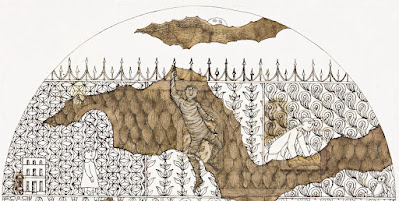The recent Illustration Art Auction at Swann Auction Galleries (December 16, 2021) sold a piece of original artwork by Edward Gorey intended to be Print #6 in the series. Sold by the Edward Gorey Charitable Trust, this is an unusual pen & ink with watercolor. In this piece, Mr. Gorey set up a visual and technical challenge for himself which he abandoned just as he was on the cusp of completing the piece. This piece of art is not in my personal collection.
This is an intricate, monumentally confusing image, and it is clear that Edward Gorey's watercolor technique did nothing to clarify the scene. In the areas where watercolor is applied, the pen and ink details of the drawing are softened. I believe the choice to blur the details had to be an intentional decision; Mr. Gorey had been combining watercolor with pen & ink on his artwork for over 40 years. The ink chosen for this drawing was clearly water soluble, so that it would blend with the sepia overpainting. In most areas where the sepia has been applied, the softening effect looks intentional, whereas in other areas the blurring obscures the image too much.
The unfinished gentleman at the bottom of the artwork could have several interpretations. The image upper left is the unfinished artwork. In the upper right image, just the areas inside the sepia have been filled in. At lower left, the gentleman's entire body has been filled in. This is similar to the burglar escaping the upstairs window; his right leg has been filled in with sepia. Filling in the leg may have been a mistake, but could also be an indication that the burglar's right leg is outside the window frame.
Another fascinating part of this piece is the swatch of wallpaper design that is taped to the lower corner of the art. On a hand drawn grid, Edward Gorey is experimenting with two layouts for a possible wallpaper design. While this design does not precisely correspond to the wallpaper patterns in the house, it shows the care Mr. Gorey took in the planning stages to create repetitive patterns. Delicately drawn pencil grids are occasionally visible (just barely) throughout the various wallpapers in the house.
We will never know how Edward Gorey intended to fully complete this piece or why he abandoned the image. We can only delight in the archeological nature of this piece of original art; it gives us an "over the shoulder" glimpse into how Edward Gorey approached a large, complicated drawing.












2 comments:
I am curious to know if you have an idea of what it sold for.
I have been attending a few Gorey item auctions and find the choices and the resultant pricing rather interesting.
Pricing can be found on the Swann website.
Post a Comment